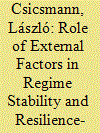| Srl | Item |
| 1 |
ID:
141865


|
|
|
|
|
| Summary/Abstract |
In this paper, the effect of liner material of the shaped charge on jet formation and its penetration capability is investigated by experimental and numerical methods. Liner materials investigated in this paper are copper, steel, and aluminium, respectively. Pulse X-ray photographic technology to shoot the formation of jet is employed to obtain the tip velocity and the diameter of jet. A two-dimensional multi-material code is designed to simulate the entire process from jet formation to penetrating a target. A markers on cell lines method is utilised to treat the multi-material interface. The results show that aluminium jet has the highest velocity with the poorest penetration capability. Copper jet has the strongest penetration capability with a velocity higher than that of steel jet, but lower than that of aluminium jet. The simulated results agree with the experimental results very well. It also indicates that the code developed can not only address large distortion problems but also track the variation of multi-material interfaces. It is favourable to simulate the explosive loading on thin-wall structure such as shaped charge. It is proved that authors’ method is feasible and reliable for optimising the structure of shaped charge jet to dramatically improve its tip velocity and penetration capability, and provides an important theoretic basis for designing high explosive anti-tank warhead.
|
|
|
|
|
|
|
|
|
|
|
|
|
|
|
|
| 2 |
ID:
188645


|
|
|
|
|
| Summary/Abstract |
This article aims to bring together the factors of resilience, regime stability, and foreign penetration into one research project based on the example of the Hashemite Kingdom of Jordan, which marked the one-hundredth anniversary of its statehood in 2021. Even though it exists in a neighborhood that is in turmoil, the Jordanian monarchy has managed to survive all the spillover effects from such regional conflicts. This study argues that external influences have played an increasingly significant role in political developments in Jordan since the beginning of the New World Order in 1989. Scholars of international relations often argue that foreign penetration may cause state vacuums like those that have arisen in Syria, Libya, Yemen, and Iraq. Yet, this has not been the case with other states in the Middle East. One important factor behind this resilience and regime stability is related to the behavior of foreign actors. With respect to the Hashemite Kingdom, the United States has historically been the main provider of state security. Nonetheless, at the same time the European Union (EU) has adopted a pragmatic view toward Jordan and its new resilience-building approach also helps to maintain the status quo. Moreover, the regional hegemons and swing states of the Middle East and North Africa (MENA) region do not have an interest in altering the existing order save for a few radical groups. The author argues that the convergence of the national interests of the major regional stakeholders also contributes to regime stability and that outside support has increased the resilience of its political system despite the growing frustrations of many of the country’s citizens.
|
|
|
|
|
|
|
|
|
|
|
|
|
|
|
|